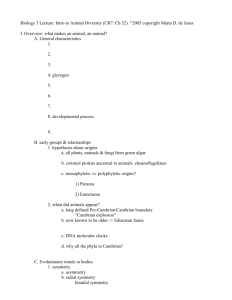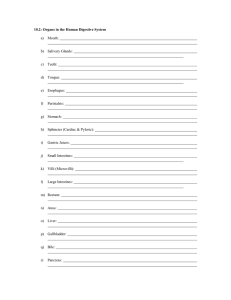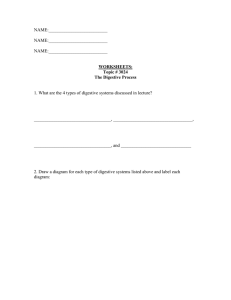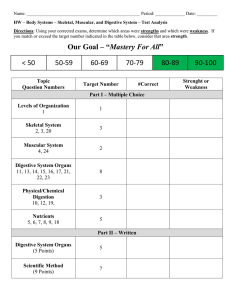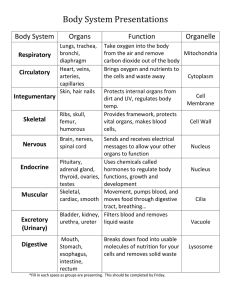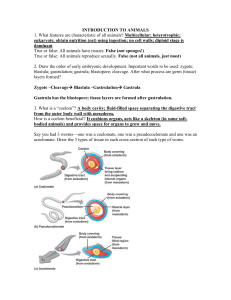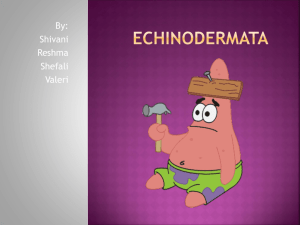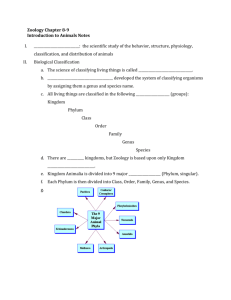INTRO TO ANIMALS (METAZOA) Multicellular/specialized cells Eukaryotic heterotrophs No cell wall/chloroplasts
advertisement
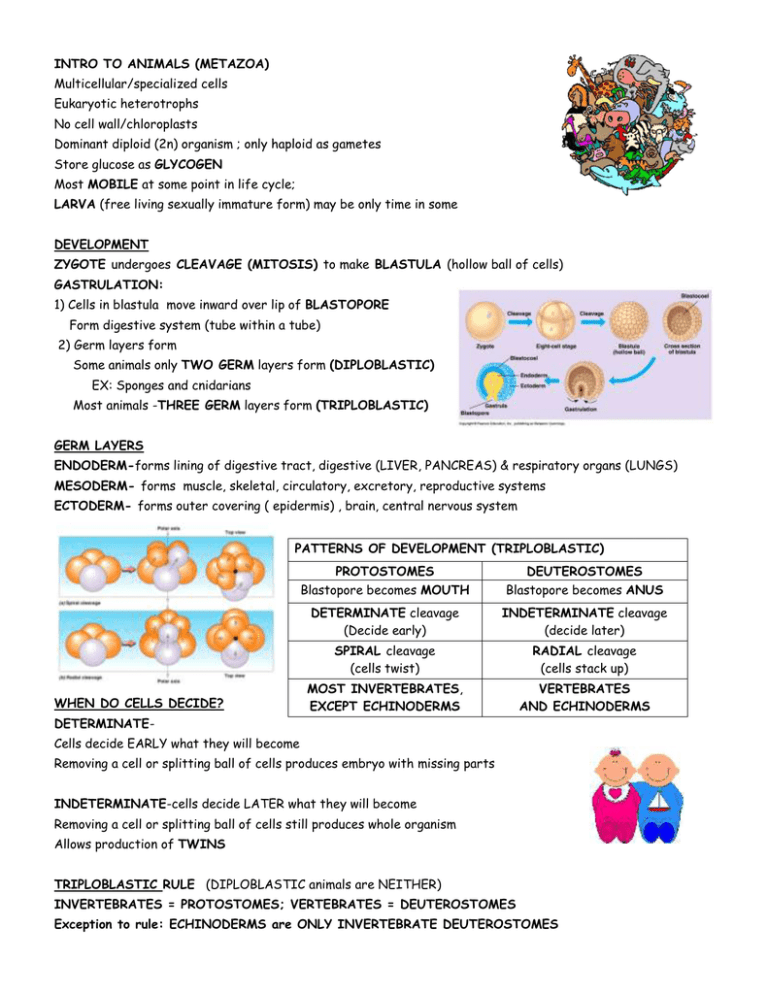
INTRO TO ANIMALS (METAZOA) Multicellular/specialized cells Eukaryotic heterotrophs No cell wall/chloroplasts Dominant diploid (2n) organism ; only haploid as gametes Store glucose as GLYCOGEN Most MOBILE at some point in life cycle; LARVA (free living sexually immature form) may be only time in some DEVELOPMENT ZYGOTE undergoes CLEAVAGE (MITOSIS) to make BLASTULA (hollow ball of cells) GASTRULATION: 1) Cells in blastula move inward over lip of BLASTOPORE Form digestive system (tube within a tube) 2) Germ layers form Some animals only TWO GERM layers form (DIPLOBLASTIC) EX: Sponges and cnidarians Most animals -THREE GERM layers form (TRIPLOBLASTIC) GERM LAYERS ENDODERM-forms lining of digestive tract, digestive (LIVER, PANCREAS) & respiratory organs (LUNGS) MESODERM- forms muscle, skeletal, circulatory, excretory, reproductive systems ECTODERM- forms outer covering ( epidermis) , brain, central nervous system PATTERNS OF DEVELOPMENT (TRIPLOBLASTIC) WHEN DO CELLS DECIDE? PROTOSTOMES DEUTEROSTOMES Blastopore becomes MOUTH Blastopore becomes ANUS DETERMINATE cleavage (Decide early) INDETERMINATE cleavage (decide later) SPIRAL cleavage (cells twist) RADIAL cleavage (cells stack up) MOST INVERTEBRATES, EXCEPT ECHINODERMS VERTEBRATES AND ECHINODERMS DETERMINATECells decide EARLY what they will become Removing a cell or splitting ball of cells produces embryo with missing parts INDETERMINATE-cells decide LATER what they will become Removing a cell or splitting ball of cells still produces whole organism Allows production of TWINS TRIPLOBLASTIC RULE (DIPLOBLASTIC animals are NEITHER) INVERTEBRATES = PROTOSTOMES; VERTEBRATES = DEUTEROSTOMES Exception to rule: ECHINODERMS are ONLY INVERTEBRATE DEUTEROSTOMES BODY CAVITY (COELOM) Animals grouped by development pattern TYPES OF COELOMS in TRIPLOBLASTIC ANIMALS Fluid filled space = COELOM Separates digestive tube from body wall Allows organs to move independently Space/cushion for organs ACOELOM No space <2 opening digestive system FLATWORMS Fluid in coelom space can: be HYDROSTATIC skeleton circulate nutrients/oxygen TYPES OF SYMMETRY PSEUDOCOELOM Coelom mesoderm only on body wall not around gut ROUND WORMS EUCOELOM Coelom Mesoderm lines body cavity on both sides SEGMENTED WORMS and everything else! CEPHALIZATION-concentration of “brain” and sensory organs at anterior end Accompanies bilateral symmetry Results in efficient response to stimuli Sense organs encounter environment 1st ASYMMETRY Ex; Porifera ( sponge) RADIAL Ex: cnidarians Adult echinoderms BILATERAL Most animals Gives body direction Allows for direction of movement NITROGEN WASTE Produced by body cells from metabolism of PROTEINS & NUCLEIC ACIDS Removed by EXCRETORY SYSTEM AMMONIA-Most TOXIC; requires most water to dilute Excreted by aquatic organisms directly into water via gills or other organs UREA- Less toxic than ammonia; requires less water to dilute excreted by amphibians, sharks, some bony fish, mammals (humans) URIC ACID- LEAST TOXIC; requires least amount of water to dilute excreted by birds, insects, reptiles to CONSERVE WATER EXAMPLES OF EXCRETORY ORGANS: kidneys, nephridia, flame cells, Green glands, Malpighian tubules EXAMPLES OF RESPIRATORY ORGANS: skin, gills, trachea & spiracles, book lungs, lungs INVERTEBRATE/VERTEBRATE BODY PLAN IS REVERSED SKELETAL SYSTEM ENDOSKELETON-bones inside EXOSKELETONprotective outer covering REPRODUCTIVE SYSTEM ASEXUAL-one parent provides DNA SEXUAL-combines DNA from 2 parents EXTERNAL FERTILIZATION- TYPES OF DIGESTIVE SYSTEMS NO OPENINGS-absorb through skin Ex: tapeworm ONE OPENING = GASTROVASCULAR CAVITY Ex: Planaria TWO OPENINGS- most efficient Allows specialization (different parts do different jobs) Most animals have this kind EX: human sperm + egg join outside mother’s body INTERNAL FERTILIZATIONsperm + egg join inside mother’s body INVERTEBRATES- no backbone Includes: Porifera, cnidarians, worms, mollusks, DIRECT DEVELOPMENT- echinoderms, arthropods juvenile is small version of adult INDIRECT DEVELOPMENT VERTEBRATES-spinal cord surrounded by metamorphosis of larva to adult form bone/cartilage (vertebrae) Includes: fish, amphibians, reptiles, birds, mammals METABOLISM ECTOTHERMIC = “cold blooded” body temperature is dependent on environment CIRCULATORY SYSTEM OPEN- Blood NOT enclosed in vessels ENDOTHERMIC- “warm blooded” uses metabolic heat to maintain body temp Ex: Most invertebrates except segmented worms; cephalopods CLOSED- Blood is enclosed in vessels Ex: vertebrates AMNIOTIC EGG important development that allowed land animals to reproduce without returning to water
